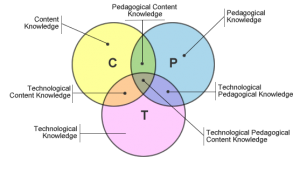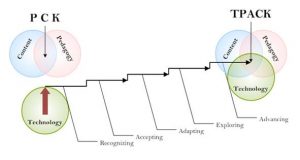The ideal pedagogical design of a technology-enhanced learning experience for math and science must first and foremost see students as constructors of their knowledge.
While Mishra and Koehler’s TPACK model seen below (Fig. 1) outlines for us how we must incorporate technology in order to provide a 21-century education the second diagram perhaps better illustrates how we move toward that (See Fig. 2).
Fig. 1

Fig. 2

Figure 2 demonstrates how we can move for PCK to TPACK. Only by recognizing the need for change, accepting technology as an excellent catalyst for change, adapting our programs to be enhanced by the technology, exploring new technological options to improve different areas of the program and finally ADVANCING our teaching with technology.
Allowing students to use technology to effectively assist in the construction of their knowledge could include, but not be limited to: simulations (often with equipment unavailable in science and math classrooms), collaboration (with peers, mentors and outside experts), design (planning their learning and pathways), coding, exploration of various concepts (perhaps outside of the realm of the current curriculum mandate), testing hypotheses (trying their ideas; seeing what works and what doesn’t). Technology is a tool for students to use in the construction of their knowledge, aided by a supportive, knowledgable teacher who can help push the boundaries of the students understanding.
Re-Statement of Design of TELE’s :
The ideal pedagogical design of a technology-enhanced learning experience for math and science must first and foremost see students as constructors of their knowledge. Allowing students to use technology to effectively assist in the construction of their knowledge could include, but not be limited to: simulations (often with equipment unavailable in science and math classrooms), collaboration (with peers, mentors and outside experts), design (planning their learning and pathways), coding, exploration of various concepts (perhaps outside of the realm of the current curriculum mandate), testing hypotheses (trying their ideas; seeing what works and what doesn’t). Technology is a tool for students to use in the construction of their knowledge, aided by a supportive, knowledgeable teacher who can help push the boundaries of the students understanding. Students learn with, not are taught by technology.
References:
Jonassen, D. H. (2000). Computers as mindtools for schools, 2nd Ed. Upper Saddle River, NJ: Merrill/ Prentice Hall. Retrieved from Google Scholar: http://scholar.google.com/scholar?q=Jonassen+mindtools&ie=UTF-8&oe=UTF-8&hl=en&btnG=Search
Kozma, R. (2003). Technology, innovation, and educational change: A global perspective, (A report of the Second Information Technology in Education Study, Module 2). Eugene, OR: International Association for the Evaluation of Educational Achievement, ISTE Publications.
Mishra, P., & Koehler, M. (2006). Technological pedagogical content knowledge: A framework for teacher knowledge. The Teachers College Record, 108(6), 1017-1054.
Roblyer, M.D. & Doering, A. (2012). Integrating educational technology into teaching, (5th Ed.). Upper Saddle River, New Jersey: Prentice Hall.
Images Retrieved from:
TPACK Framework Fig 1: Mishra, P., & Koehler, M.J. (2006). Technological pedagogical content knowledge: A new framework for teacher knowledge. Teachers College Record, 108(6), 1017-1054. doi: 10.1111/j.1467-9620.2006.00684.x
TPACK’s development Fig 2: Niess, M., Ronau, R., Shafer, K., Driskell, S., Harper, S., Johnston, C., Browning, C., Özgün-Koca, S., & Kersaint, G. (2009). Mathematics Teacher TPACK Standards and Development Model. Contemporary Issues in Technology and Teacher Education, 9(1), 4-24.